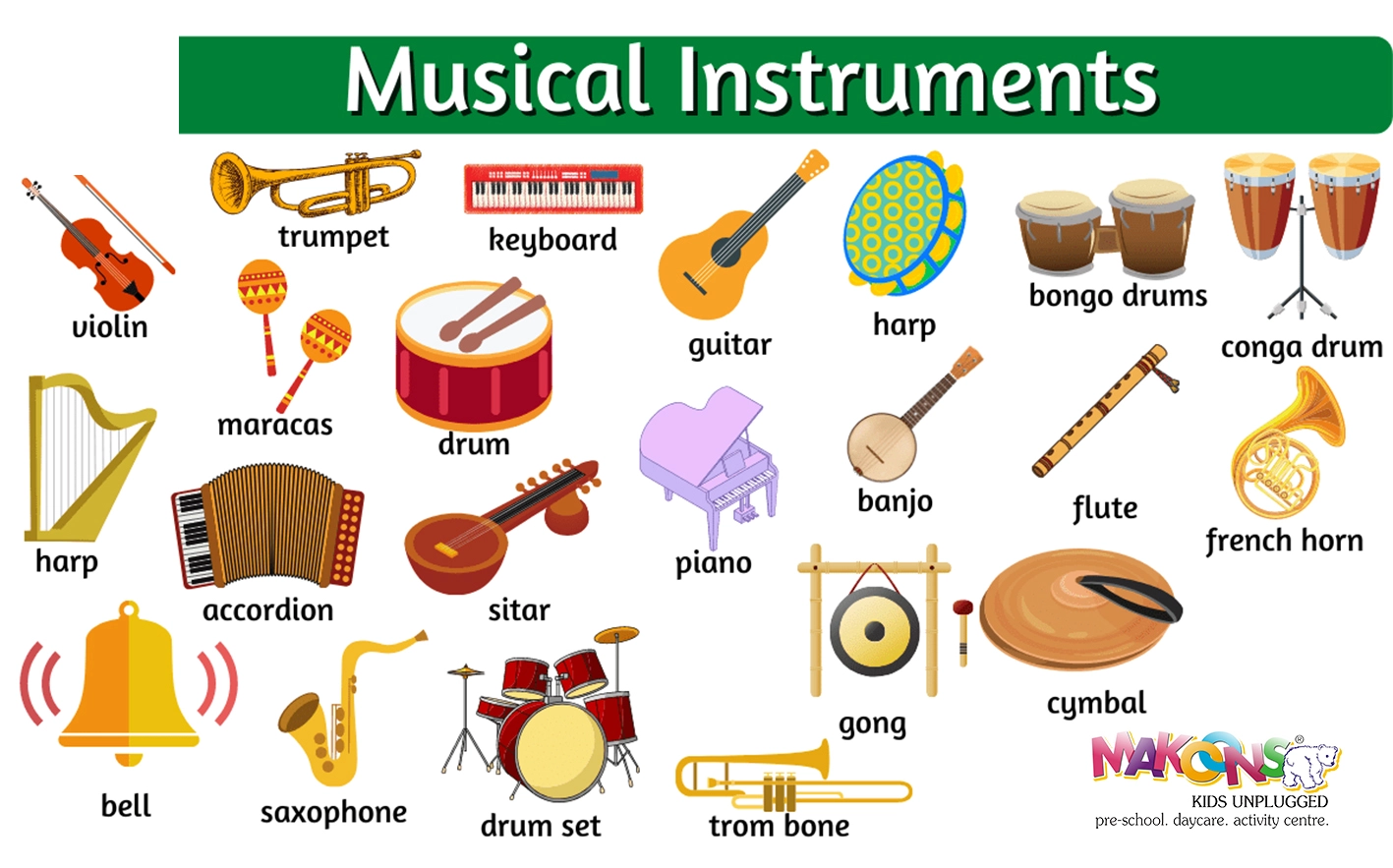A famous quote by Plato on music say’s “Music gives a soul to the universe, wings to the mind, flight to the imagination, and life to everything.”
At Makoons Preschool, we strongly believe that music is a great tool to help your kids grow, learn, and know how to easily express themselves. And the best way to introduce music to kids is by teaching them musical instruments by name. In this blog, we will understand the importance of music in the development of child growth, different types of musical instruments with their examples, how they work, and how Makoons Preschool brings out creative ways to introduce kids to music.
Why Should Kids Learn About Musical Instruments?
It’s a psychological fact that kids who start early to learn about music develop faster than other kids. Learning musical instruments by name is not just about the sound and melodies, but it’s about building a lifetime skill.
Benefits of Music for Preschoolers
- Boosts Memory: Knowing instrument names like “piano” or “flute” sharpens memory.
- Ignites Creativity: Experimenting with sounds helps kids think outside the box.
- Improves Coordination: Beating drums or shaking maracas enhances motor skills.
What Are Musical Instruments?
Musical instruments are tools that make sounds. Some you hit, some you blow, and some you strum! Let’s break them into four types:
- Percussion: Drums, xylophones (you hit or shake them!).
- String: Guitar, violin (you pluck or bow the strings!).
- Wind: Flute, harmonica (you blow air through them!).
- Keyboard: Piano, keyboard (you press keys to make notes!).
20 Common Musical Instruments Names- (With Fun Facts!)
Here’s a list of musical instruments names every child should know!
| Name | Type | Fun Fact |
| Accordion | Keyboard | Squeeze the bellows to make a sound. |
| Bongo Drums | Percussion | Played with hands—perfect for little kids. |
| Castanets | Percussion | Click them like clapping hands. |
| Drum | Percussion | Builds rhythm skills. |
| Flute | Wind | One of the oldest instruments. |
| Guitar | String | Has 6 strings to strum. |
| Harmonica | Wind | Fits in your pocket. |
| Keyboard | Keyboard | Plays many sounds with keys. |
| Maracas | Percussion | Shake them like a rainmaker. |
| Recorder | Wind | Often the first wind instrument for kids. |
Here Are 10 More Musical Instruments Every Kid Should Know!
- Violin – String
- Trumpet – Brass
- Trombone – Brass
- Cello – String
- Xylophone – Percussion
- Clarinet – Wind
- Tuba – Brass
- Banjo – String
- Triangle – Percussion
- Oboe – Wind
Musical Instruments by Name – A to Z List for Kids
Let’s explore musical instruments by name from A to Z.
Let’s dive deeper into the world of musical instruments by name! From the lively accordion to the enchanting zither, here’s a fun, detailed guide to help kids (and parents!) explore sounds, cultures, and creativity.
A – Accordion
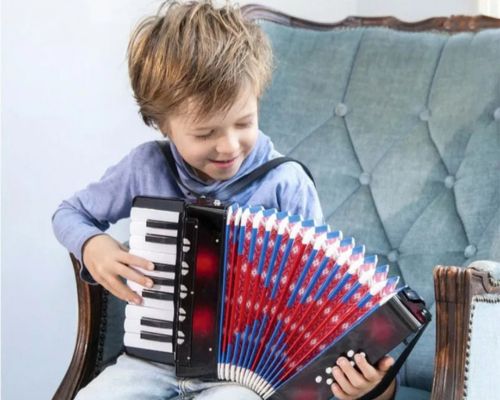
The accordion is a box-shaped instrument with keys on one side and buttons on the other. Squeeze the bellows (the folding part) to push air through the reeds, creating rich, lively sounds. It’s popular in folk music, like polka or tango.
Fun fact: Some accordions weigh as much as a toddler.
B – Bongo Drums
Bongo drums are a pair of small, open-bottomed drums from Cuba. The smaller drum (macho) makes high pitches, and the larger one (hembra) creates deep tones. Play them with your palms or fingertips!
Why kids love it: Bongos are perfect for fast, energetic rhythms—great for dance parties.
C – Castanets
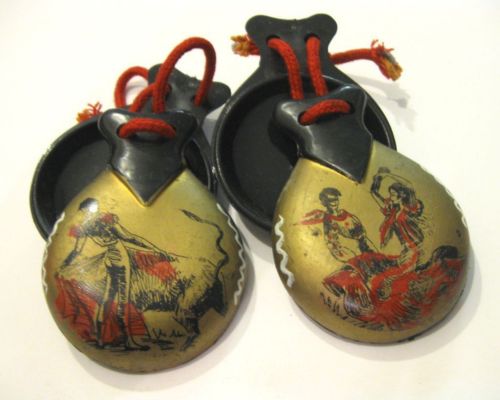
Castanets are wooden or plastic clackers from Spain. Hold them in your hands and click them together to add clickety-clack rhythms to flamenco dances!
Activity idea: Use castanets during clapping games to practice coordination.
D – Drum
Drums come in all shapes—snare drums, bass drums, or djembe drums! Beat them with sticks, brushes, or hands. Drums are some of the oldest musical instruments by name, used in ceremonies worldwide.
Fun fact: The world’s largest drum is over 12 feet wide.
F – Flute
The flute is a slender wind instrument made of metal or wood. Blow across the mouthpiece hole to create soft, airy melodies. Native American flutes are carved from cedar.
Kid-friendly tip: Start with a recorder—it’s simpler for small hands.
G – Guitar
A guitar has six strings that you strum or pluck. Acoustic guitars are great for campfires, while electric guitars rock out with amplifiers.
Did you know? The smallest guitar is known as the ukulele.
H – Harmonica
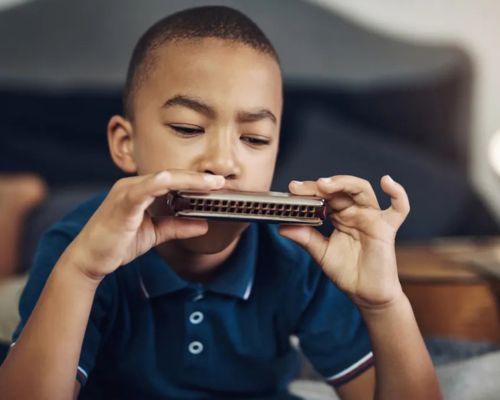
The harmonica is a pocket-sized wind instrument. Blow or suck air through its holes to play blues, folk, or even rock music.
Fun activity: Pretend to be a train conductor— with harmonica sounds.
K – Keyboard
A keyboard is an electronic version of a piano. Press its keys to play piano, or synth sounds—some even have animal noises.
M – Maracas
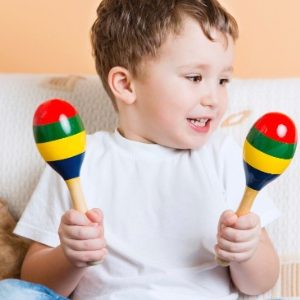
Maracas are shakers from Latin America. Fill them with beads or rice, then shake to make festive rhythms!
Craft idea: Make DIY maracas using empty water bottles and dried beans.
R – Recorder
The recorder is a simple wind instrument often used in schools. Cover the finger holes to play notes like “Hot Cross Buns.”
Pro tip: Practice blowing softly—no ear-piercing squeaks.
T – Tabla
The tabla is a pair of Indian drums. The smaller drum (on the right) and the larger one (on the left) create complex rhythms in classical music.
Try this: Tap your knees like a tabla player during storytime.
U – Ukulele

The ukulele is a tiny, four-stringed guitar from Hawaii. Its cheerful sound makes it perfect for songs like “Somewhere Over the Rainbow.”
Kid-friendly fact: The name means “jumping flea” in Hawaiian.
V – Violin
The violin has four strings played with a bow. It’s a star in orchestras and also comes in kid-sized versions.
Fun challenge: Can you make a sound like a singing bird?
X – Xylophone
A xylophone has colorful wooden or metal bars. Strike them with mallets to play bright, ringing notes.
Z – Zither

The zither is a flat string instrument from Europe. Pluck its strings while it lies on your lap for gentle, harp-like music.
Did you know? The zither was featured in the Harry Potter movies.
Why Learn Musical Instruments by Name?
Recognizing musical instruments by name helps kids:
- Build vocabulary (e.g., “xylophone” vs “glockenspiel”).
- Connect sounds to cultures (tabla from India, castanets from Spain).
- Discover their favorites—maybe they’re future drummers or flutists!
How to Teach Kids Musical Instruments by Name?
This is how you can teach you kids about musical instruments names in Easy way with fun activities-
1. Use Flashcards & Books
Show cards with instruments names and pictures. Ask, “What’s this?”
2. Watch Music Cartoons
Shows like Bluey or Cocomelon introduce musical instruments with a list of sounds and names.
3. Visit a Music Shop
Let kids touch a real guitar or piano! Say, “This is a drum!”
4. Hands-On Play
Give toy instruments and ask, “Can you play the maracas?”
Fun Activities to Learn Musical Instruments
Name-That-Sound Game
Play sounds of musical instruments by name (e.g., flute, drum) and let kids guess.
DIY Instrument Crafts
Make a shaker with rice in a bottle or a guitar with rubber bands and a box.
Matching Worksheets
Match instruments names like “violin” to their pictures.
Sing-Along Time
Sing “Old MacDonald Had a Band” with instrument sounds.
Why Music Matters in Preschool?
At Makoons Preschool, music isn’t just fun—it’s part of learning.
- Social Skills: Group music time teaches teamwork.
- Math Basics: Counting beats introduces numbers.
- Focus: Following rhythms improves attention spans.
How Makoons Preschool Brings Music to Life?
- Weekly Music Sessions: Kids explore musical instruments by name, like xylophones and tambourines.
- Toy Instrument Play: Safe, colorful instruments for hands-on learning.
- Dance & Movement: March like a drum band or sway like a flute melody!
Also Read other Blog To teach your kids about- 20 Famous Dry Fruits Names : With Benefits
Conclusion: Let the Music Begin!
Teaching kids musical instruments by name is like giving them a key to a magical world. At Makoons Preschool, we mix fun with learning to help your child grow. So, let’s shake those maracas, tap the drums, and sing along—because every child deserves a soundtrack to their childhood!
Ready to join the band? Visit Makoons Preschool today.
FAQ’s
Which Musical Instrument Is Easiest to Learn for Beginners?
The ukulele, keyboard, and harmonica are among the easiest musical instruments for beginners. They have simple learning curves, affordable pricing, and readily available online tutorials, making them ideal for new learners.
What Are the Best Musical Instruments for Kids to Start With?
The best musical instruments for kids include the recorder, xylophone, mini-keyboard, and small-sized guitars. These instruments are lightweight, easy to handle, and help develop basic musical skills while keeping children engaged.
How Do I Choose the Right Musical Instrument for Me?
To choose the right musical instrument, consider factors like your musical taste, budget, physical comfort (size & weight), and long-term commitment. Trying out different instruments before purchasing can also help you find the best fit.
What Are the Benefits of Learning a Musical Instrument?
Learning a musical instrument improves cognitive skills, enhances memory, reduces stress, boosts creativity, and increases discipline. It also provides a sense of achievement and can be a great social activity through bands or orchestras.
